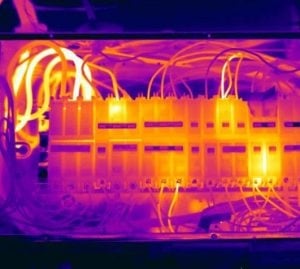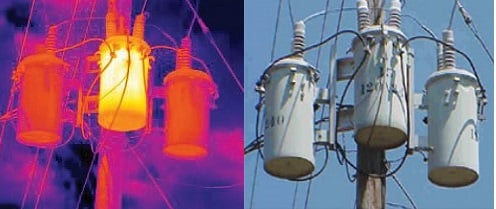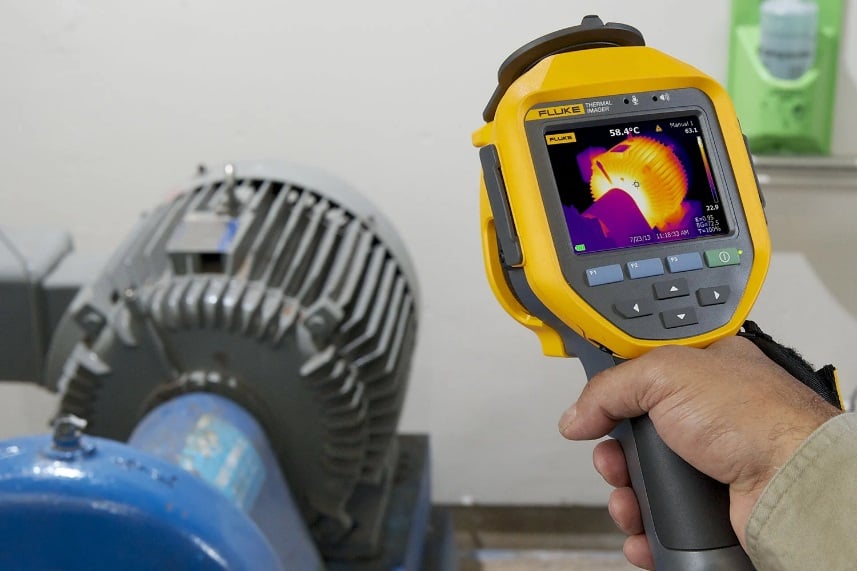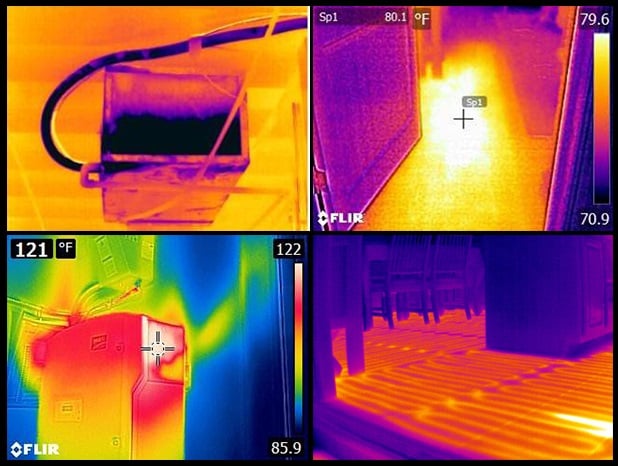This article looks at thermal imaging equipment and discusses the advantages and applications of thermal imaging in a variety of control systems.
Thermal imaging is a technique that enables us to visualize and see the thermal qualities of any object, whether living or non-living. Every object radiates heat energy, and this emission of heat energy shows and represents different types of behavior. For example, in the case of fever, body temperature increases from the normal temperature. By analyzing the temperature (thermal quality) of the body, the doctor can predict the illness and suggest medication.
The same is the case with machines. If the temperature is greater than normal, operators can detect the abnormality causing the increase in temperature and rectify the problem.
This article looks at thermal imaging equipment and discusses the advantages and applications of thermal imaging in control systems.
Thermal Imagers and Cameras
Thermal imaging is done by specialized equipment, often called thermal imagers or thermal cameras. Thermal imagers capture infrared radiation of the electromagnetic spectrum, of which visible light is also part.
The infrared radiation level, which is a function of heat, is displayed by these thermal imagers in the form of temperature values. Thermal imagers show the data in the form of a picture, representing different values of the object’s temperature, contrary to other measuring devices that give numerical values.
Advantages of Thermal Imaging
Thermal imaging has revolutionized the method of error detection and correction. Although it is somewhat costlier than other options, the advantages it offers are still enticing. Thermal imaging compensates for the higher cost by offering advantages that other options do not.
Some of the advantages that industries are finding with the use of thermal imaging include (but aren’t limited to):
- Doesn’t interrupt normal system operation
- Is a safe, non-intrusive process
- Provides immediate results and reports
- Allows for proper maintenance planning and execution
Thermal Imaging is Done During Normal Running Conditions
Thermal imaging is performed under normal running conditions without stopping the machine or process, unlike other physical and measurement techniques that require a shutdown. The resources for thermal imaging are also not dedicated to specific operators or maintenance staff, so it can be performed on the go.
Safety For Personnel and Machinery
Thermal imaging can be done without coming in direct contact with the process or machinery, resulting in a safer option for man and material.
This advantage is especially useful in industries that have requirements critical to human safety like chemical processing plants, steel or metal foundries, and power generation plants.
Immediate Results and Report Generation
The results of the thermal imaging are handy and are available immediately. The report can be made on the premises without going anywhere. Also, no advanced expertise and external contractor is required.
These reports can also be shared with an expert for necessary suggestions.
More Effective Maintenance Planning
Thermal imaging helps with identifying defects that are not easily visible. Identifying these defects before they create larger problems helps with planning maintenance activities that do not affect a critical production plan.
This also helps prevent unnecessary maintenance activities, thus avoiding unnecessary costs while increasing machinery effectiveness.
Applications of Thermal Imaging
As mentioned above, the heat emission pattern is different on any object and depends on the current situation. By studying this heat pattern we can have an idea about the condition of the object.
Analyzing the thermal imaging of different machines gives an idea of any malfunctioning, enabling operators to prepare ahead. Let’s look at some industries where thermal imaging is being effectively used.
Electrical Panels
As electrical energy passes through any conductor, it generates heat. This is no problem at all. But in cases where the heat is greater than the normal values or ranges, it is a situation that needs to be inspected.

Figure 1. Thermal imaging helps measure heat signatures in electrical panels.
Excessive heat could be due to electrical malfunction in the circuit or unwanted resistance. By inspecting the particular electrical component like a circuit breaker or a conductor, one can track the cause of this excessive heat generation. It can be also beneficial for:
- Making unevenly distributed load to evenly distributed load
- Finding unbalance phases of power supply
- Locating and eliminating loose connections and conductors
- Detecting overrated or underrated electrical components
Transformers in Power Systems
A transformer is an important device within power supply systems. Thermal imaging is an effective method for monitoring the transformer’s state.

Figure 2. Checking a transformer’s state can be done using thermal imaging. Image courtesy of Flir.
It is not possible to physically inspect the transformer often due to the challenge of accessing the transformer. So thermal imaging is used to monitor and inspect its condition.
Thermal imaging is used to inspect the transformer for a variety of possibilities:
- Cooling system: In transformers, oil is used as a cooling mechanism by circulating in the tubes. Thermal imaging of these tubes helps verify the correct working of the cooling system.
- High- and low-level voltage connections: The condition of the high- and low-level voltage can be checked for loose or broken connections.
- Installed electrical components like breakers, fuses, and cables: We can analyze the electrical components associated with the transformer to get a broad overview of its condition.
Motor Inspection
The motor is one of the basic parts of any machinery, and the whole operation depends on the normal and satisfactory working of the motor. Therefore, thermal imaging is effectively used for the possible cause of malfunctioning. When inspecting motors, the following must be considered:
- Motor Housing: All the components within a cover called housing. Any problem in the motor will cause the motor housing to quickly heat up.
- Cooling Fan: Check the condition of the cooling fan attached at the rear of the motor by making sure that there is no abnormal heat pattern present.

Figure 3. There are a variety of things that thermal imaging can check in a motor. Image courtesy of Fluke.
- Connection Box: Look for any hot points in the connection box. Any unwanted hot surfaces could be a sign of a loose, damaged, corroded, or shorted connection.
- Attached Shaft: Normal heat pattern in the shaft portion indicates that the bearing is in good condition and is working fine. The coupling must also stay in a satisfactory condition free from any misalignment.
HVAC
HVAC systems create specific environmental conditions for different requirements, for example, product manufacturing or certain room conditions in the health care industry.

Figure 4. Thermal imaging gives a good idea of how an HVAC system is performing. Image courtesy of Flir.
Thermal imaging is used to detect heat loss in HVAC systems due to leakages in ducts or problems with the insulation system. If there is a leakage, then the cooled or warm air will be escaping from the duct. This temperature difference can be detected by a thermal imager, allowing for quick fixes.
It also helps by detecting blockages in a duct system due to mechanical system failure or a foreign body in the duct.
Predictive Maintenance
Thermal imaging can be used as a part of a predictive maintenance plan. By regularly inspecting systems — both electrical and mechanical — you can avoid unnecessary breakdowns by analyzing the present condition of equipment and based on the results you can easily predict the life of the component.
Any upcoming faults or problems can easily be identified, and by planning maintenance activity accordingly, you can easily avoid system failure or breakdown.
Copyright Statement: The content of this website is intended for personal learning purposes only. If it infringes upon your copyright, please contact us for removal. Email: admin@eleok.com
